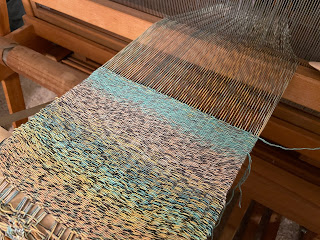This is an 8-shaft Gilmore loom with 12 treadles and a 40" weaving width. It has a sectional warp beam and easily removeable breast beam (the beam just sits on some dowels, no bolts or anything, super convenient). And it was made in June of 1987. Older than me!
The loom has the original metal heddles and original cotton tie-ups. I don't think Gilmore sells either of those anymore. Gilmore also doesn't sell 40" looms now, as far as I can tell. When I contacted them about extra reeds, Bob told me they weren't going to be restocking reeds for the 40" and referred me to the Woolery. Unfortunate but understandable.
I paid $700 for it, which I think was a pretty fair price. It's in perfect working condition, but didn't come with a bench (the bench in the picture is my piano bench), and didn't come with accessories like a shuttle or bobbin winder (the shuttle in the picture is one I bought the same day as the loom).
Probably too much unecessary detail in those last few paragraphs, but I'm very excited about all those unecessary details.
Warping a floor loom is somehow less frustrating and tedious than warping a rigid heddle loom. I'm not sure what it is. Threading the heddles was kind of fun, and hopefully the novelty of the experience won't wear off.
Weaving on a floor loom is much more physically-involved than weaving on a rigid heddle. It's still a much faster process than weaving on a rigid heddle loom though, mostly because of the boat shuttle.
This loom is well-made and really enjoyable to use. I'm looking forward to weaving on it as much as possible in the future.
Hand-winding bobbins is fun, but I think I'll go crazy if I have to wind more than half a bobbin of very fine yarn.
My first bit of weaving! The selvages are very wonky, but I have remedied the issue. Mostly due to the cloth line (?) being too far from the reed, and the bobbins being wound too loosely.
And now for some other random thoughts and things I learned:
- Don't drop the cross when warping.
- DON'T DROP THE CROSS WHEN WARPING.
- don't drop the cross when warping.
- Wind bobbins really tightly, but do not overfill them.
- Less tension on the warp isn't a bad thing.
- The warp has to go over the back bar before being threaded...
- Release a bit of tension on the cloth beam before advancing the warp.
- I learned how to read a weaving pattern.
- I learned why my tension was so bad: "My selvages are loose with loops extending beyond the weaving. Why?".
- I learned about sett/yarn weight, which is A Thing I know of but continuously forget how both the things line up.
- Another Thing I know but continuously forget is hemstitching.



Comments
Post a Comment
Comments? Concerns? Criticism?